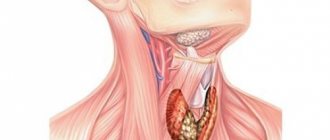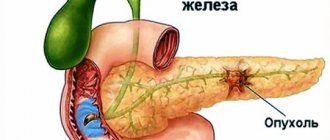Thyroid cancer is the appearance of a malignant tumor of a non-aggressive nature in the tissues of the gland. The ICD-10 code for carcinoma is C73 “Malignant formation of the thyroid gland.” Cancerous nodes have a heterogeneous structure, have uneven outlines, and weakly reflect the ultrasound wave. Some have intense blood circulation. As a result of oncology, secondary growth foci are formed, new tumors called metastases. Metastases occur when cancer cells travel through the lymph or blood from the site of oncology to other tissues and organs of the body.
The functioning of the thyroid gland is imperceptible to humans and does not bother them if it is healthy. Functional disorders in the functioning of this internal secretion organ are possible, for example, oncology. Thyroid carcinoma is rare. In Russia, the frequency of this type is 3% of oncological diseases of other organs, but medical statistics show an increasing trend in incidence. The level of development of medicine has the necessary means to treat a malignant tumor in the tissues of the thyroid gland. It is important not to delay treatment.
The essence of thyroid carcinoma
Foci of the spread of the disease are associated with populated areas where radiation exposure has been recorded. Elderly people are at risk for thyroid cancer. But there have been cases of carcinoma at a young age, and the course of cancer in young people is much more aggressive than in old people. The Caucasian race is vulnerable to this type of cancer. In women, the pathology occurs more often than in men, but it is also easier to tolerate.
The process of formation and spread of metastases occurs slowly; the tumor may not grow in size for many years. But this is not a reason to postpone a visit to the doctor: thanks to early diagnosis and selection of competent treatment, a complete cure for thyroid cancer is possible.
What are metastases and how do you know about their appearance?
If primary thyroid cancer is diagnosed, metastases will form a secondary site of malignancy in the lymph nodes (regional or local) of the lungs, liver or spine.
With papillary thyroid cancer, metastases spread through the lymphogenous route with the formation of secondary foci in the neck, in the trachea and pharynx, and in the neurovascular bundle. Metastases can be partially detected in the area of the lymph nodes: preglottic, peritracheal and cervical.
In follicular thyroid cancer, metastases are spread by the bloodstream. They can be found in the tissues of the lungs, in the inert tissues of the ribs and vertebrae of the thoracic region, as well as the lungs. Then you can recognize them by the appearance of a cough with blood, shortness of breath, difficulty breathing, and constant fatigue. Infiltrates or secondary foci of cancer of varying sizes and numbers form in the lungs.
With anaplastic and medullary thyroid cancer, the consequences are much worse, since metastases spread through hematogenous and lymphogenous routes. They are found in organs and lymph nodes. This type of cancer is quite rare, but very aggressive. Metastasis can occur even at an early stage of the disease. The lungs and bones, liver and brain are affected. Metastases involve the skeletal system of the skull, ribs, spine, pelvis and hips. Therefore, you can learn about the appearance of metastases by pain syndromes and frequent pathological fractures. The x-ray shows voids or dark growths.
In the brain, metastases from thyroid cancer manifest as migraine-like headaches that cannot be relieved with painkillers.
Recurrence of thyroid cancer with metastases to the liver provokes jaundice and disrupts digestion. The patient will feel heaviness on the right side under the ribs. Severe cases result in internal bleeding, which results in bloody stools and vomit that looks like coffee grounds.
Metastases in the adrenal glands may not manifest themselves in any way. Only severe damage to these glands will reduce the level of sex hormones and lead to acute adrenal insufficiency. Then the signs of thyroid cancer, the first symptoms of relapse, will appear as a sharp decrease in blood pressure and impaired blood clotting.
Types of thyroid cancer
The thyroid gland, as an endocrine gland, produces hormones that perform various functions in the body and is made up of different types of cells. Thyroid tumors are divided into benign and malignant. TNM classification divides cancer into types depending on the cells affected by the cancer.
Papillary thyroid adenoma
Papillary cancer
The surface of this malignant formation has a mass of protrusions in the form of papillae. The outline of the tumor resembles a fern leaf. The tumor invades the functional parts of the thyroid gland and goes through a number of stages in its development. Concomitant pathologies include chronic atrophic gastritis, hypertension, obesity, deforming osteoarthritis of the knee joints, and calculous cholecystitis.
This is a common type of thyroid cancer, otherwise called molecular cancer. In terms of severity, papillary cancer is the mildest type of thyroid cancer. Cancer develops slowly, and metastases in this form do not spread to the lungs and bones. The difficulty in diagnosing papillary cancer is that its cells are similar in appearance to normal thyroid cells. It responds well to treatment.
Papillary tumors are 3 times more common in women. The age threshold for incidence is 30-50 years of age. After completing a course of treatment, patients live into old age without side effects or recurrence of pathology.
It is known that all people have cancer cells. During examination, many are diagnosed with tiny papillary oncologies of the endocrine gland, which, with longitudinal medical observations, do not progress in size and do not cause concern to the person. It is possible to diagnose the disease in the initial stages using palpation or ultrasound. As long as the cancer does not enter the active phase, treatment is not required. The most effective treatment method is surgery.
Follicular cancer
Oncology looks like bubbles. This type of cancer is divided into types: invasive and minimally invasive. The classification is based on the growth of cancer cells into blood vessels and into neighboring tissues and organs.
In the minimally invasive form, the tumor is localized in the thyroid gland and does not spread throughout the body. The invasive form of cancer proceeds aggressively with the germination of cancer cells into the blood and the spread of the pathological process to neighboring organs and tissues. In the follicular form of thyroid carcinoma, metastases spread to the skin, lungs, brain, bones, and bladder.
Statistics show the effectiveness of using radioactive iodine in patients under 50 years of age. In patients over 50 years of age, the disease develops widespread metastases.
The prevalence of cancer is 15-20% of all malignant processes in the thyroid gland. The invasive form is more common than the minimally invasive form. Statistics show frequent cases of death with the invasive form. Elderly women are at risk for this type of thyroid cancer. If we talk about identifying oncology in children, they are usually diagnosed with just this type of cancer.
Medullary cancer
This is a type of oncology that develops from parafollicular cells, the function of which is to produce the hormone calcitonin. The variety occurs in 5-8% of cases of thyroid cancer. Calcitonin determines the content of phosphorus and calcium in the body, determining the condition of the skeleton. In the medullary form of thyroid cancer, other endocrine pathologies are detected, for example, endocrine neoplasia.
This type of cancer is dangerous because cancer cells grow through the capsule into the muscles and trachea. This form of oncology can be diagnosed by signs such as loose stools, sudden short-term increases in body temperature, and redness of the skin. Radioactive iodine therapy is not applicable to this form, since cancer cells of this type of tumor do not absorb iodine. Therefore, only surgery seems to be an effective treatment.
Patients over 40 years of age are at risk for this type of cancer. When patients over 50 years of age seek treatment, the likelihood of recovery decreases. This type of oncology is caused by a genetic predisposition. But this type of malignant tumor also has a non-genetic variety - sporadic thyroid cancer.
Anaplastic cancer
This type of cancer is characterized by the development of atypical cells in the body of the thyroid gland, which do not perform any functions, but only divide at a rapid speed. The swelling in the thyroid gland is visualized by the patient independently. The detection of a swelling indicates the onset of late stages of oncology, in which the tumor is dense to the touch and increases in size every day. This type of oncology is rare.
Read also Gout. Symptoms, causes, prevention and treatment of gout
The disease occurs more often in women over 65 years of age and is characterized by the growth and rapid spread of metastases. This type of oncology is differentiated and can even originate in the goiter. It lasts for a long time in a hidden form. If metastases have spread to the cervical lymph nodes, surgery is impossible due to the pathological process taking over vital parts of the neck - the likelihood of death increases. This type of cancer cannot be cured. The use of intensive therapy options - hyperfractionated radiation therapy, chemotherapy - is ineffective. After detection of such oncology, patients live for a year.
Extremely rare types of thyroid cancer
These include metastatic cancer, sarcoma, fibrosarcoma, lymphoma and epidermoid cancer.
About the disease
Cancerous lesions of the thyroid gland are malignant formations of a nodular structure, formed from follicular epithelial cell structures. There are many types of thyroid cancer, but differences can often only be detected histologically.
Experts note that thyroid cancer is a relatively rare pathology. It accounts for only 1.5% of the total cancer incidence.
According to statistics, women are affected by malignant thyroid oncology 3-4 times more often than the stronger sex. Pathology is usually found in patients 40-60 years of age.
Thanks to this localization, thyroid cancer is detected and recognized in the early stages of development, which has a favorable effect on treatment prognosis. The disease code according to the ICD classification is C73.
Features of the disease in women
As has already been clarified, women suffer from thyroid cancer three times more often than men.
Most often, women are diagnosed with the papillary oncoform, which is characterized by slow development and course with rare cases of metastasis.
This type of oncology accounts for about 75% of cases of thyroid oncology.
Photo of thyroid cancer in a woman
In approximately half of patients, the development of cancer is preceded by pathology of the genital organs. In other cases, malignant thyroid oncology develops as a result of unfavorable heredity, mental trauma, age-related characteristics, or thyroid and endocrine pathologies.
Sometimes malignant oncological processes develop under the influence of mammary glandular diseases of dyshormonal etiology.
In men
In the stronger half of humanity, thyroid cancer is detected quite rarely. This pathology is more typical for men living in regions with iodine deficiency.
As for age-related characteristics, such oncology in men is divided into two categories: juvenile cancer (in the period of 10-20 years) and thyroid malignant oncology in middle age (45-60 years). Most cases (≈70%) occur in the middle-aged male population.
According to statistics, per 100 thousand population, 1 man and 2-3 women die annually from thyroid cancer.
The first sign of thyroid cancer is the appearance of a lump in the neck area. Only then, with the development of the tumor process, other clinical signs of pathology appear, such as shortness of breath, cough, hoarseness, dysphagia, etc.
In children
Children suffer from thyroid cancer much less often than adults. Most often, this disease is detected at 8-14 years of age, in 70% of girls. But experts talk about a tendency for cases of such oncopathology to become more frequent in young children.
Children are usually affected by the papillary form of oncology, which is characterized by slow development and a less aggressive course.
- In children, thyroid cancer usually occurs due to radiation exposure. According to statistics, approximately 50% of patients underwent a course of X-ray therapy in the cervical or thoracic area before the detection of cancer. Cancer usually occurs 8-10 years after treatment.
- In addition, nodular goiter can provoke thyroid cancer .
The peculiarities of childhood thyroid cancer are a short non-invasive phase, predominantly highly differentiated oncoforms, and a frequent combination of tumor processes with other thyroid pathologies.
Risk factors for developing thyroid cancer
Main risk factors:
- Iodine deficiency
- Ionizing radiation (Radiation)
- Heredity (Family History)
Risk factors also include the presence of nodules in the thyroid gland in patients, i.e. nodular goiters, their recurrent forms, nodular forms of chronic thyroiditis.
Iodine deficiency
Regions of the world with low iodine content in water and food products are endemic for nodular goiter, against which thyroid cancer often develops. In the Russian Federation, the Altai Territory and the Republic of Adygea are considered endemic areas.
Ionizing radiation
From the moment this physical phenomenon was discovered until now, the role of this factor as a cause of the development of thyroid cancer has increased sharply. The effect of this factor is primarily associated with the ingestion of radioactive isotopes of iodine (131I,125I). Thus, it was found that residents of Hiroshima and Nagasaki, who were exposed to radiation after the explosion of atomic bombs, suffered from thyroid cancer 10 times more often than other Japanese.
In Russia, there was a sharp increase in the incidence of thyroid cancer, especially in children, in regions that were exposed to radioactive contamination after the accident at the Chernobyl nuclear power plant, these are the Bryansk, Tula, and Ryazan regions.
Heredity
The risk of developing thyroid cancer is higher in families where there have been cases of this disease. The hereditary form of cancer is associated with hereditary syndromes of multiple endocrine neoplasia (MEN).
Your actions
- It is necessary to perform an ultrasound of the neck to confirm that the palpable formation is located in the thyroid gland.
- It is necessary to take a blood test for thyroid hormones (TSH) to assess the function of the organ being tested.
- If ultrasound reveals a nodular formation less than 1 cm and no signs of malignancy are detected, then such a node is dynamically observed, but if the node changes with signs of malignancy, it is necessary to perform a puncture fine-needle aspiration biopsy (PTNA) of the node under ultrasound control.
- If a nodular formation larger than 1 cm is detected, a PTAB must be performed to confirm the diagnosis. Next, the resulting material is examined in the laboratory under a microscope, on the basis of which further treatment tactics for the patient are determined.
- If you have been diagnosed with increased thyroid function, then an additional research method will be scintigraphy. And if there is insufficient visualization of the gland (especially if the node is located substernally), computed tomography is the method of choice.
For timely diagnosis and treatment, it is necessary to consult an endocrinologist who will create a treatment plan that is most suitable for you.
Reasons for the development of the disease
Under normal conditions of the body's functioning, the immune system suppresses the formation of cancer cells in the body. But under unfavorable circumstances, it malfunctions. Causes of thyroid cancer development:
- Radioactive exposure. After the accident at the Chernobyl nuclear power plant, the prevalence of thyroid cancer increased 15 times. After a nuclear weapon test, radioactive rain is possible, which is as destructive as radiation.
- The patient undergoes a course of radiation therapy in the neck and head. In this case, the occurrence of the disease is not immediately predicted. It may appear in a few years. After radiation therapy, the rate of cell division increases and the risk of cell mutation increases. This leads to the development of follicular and papillary thyroid cancer.
- Frequent computed tomography and x-ray diagnostics.
- Genetic predisposition. Genetic scientists have identified a special gene in the human genome that in 100% of cases leads to the formation of thyroid cancer.
- Age over 40 years. As a result of the aging of the body, the cells of the thyroid gland malfunction, which can cause the formation of a malignant tumor.
- Iodine deficiency in the body and in the food consumed.
- Work in medicine with ionizing radiation, work in hot shops, work in production where conditions are associated with high concentrations of heavy metals in the air.
- Tobacco smoking and alcoholism. Tobacco smoke contains carcinogens, and drinking alcoholic beverages reduces the body's biological defense against pathological processes.
- Emotional stress and a tendency to depression reduce immunity to any disease, including cancer.
- Chronic diseases of the uterus or ovaries in women, benign or malignant process in the mammary glands. This group of diseases is accompanied by hormonal disorders. Improper functioning of the endocrine glands is a risk factor for oncology.
- Colon cancer and rectal polyposis.
- Multiple endocrine neoplasia.
- Multinodular goiter. Living in an area where a source of endemic goiter has been identified is a prerequisite for the development of thyroid cancer.
- Benign tumors in the tissues of the internal secretion organ.
Thyroid cancer can develop from other diseases not associated with the formation of malignant tumors. Preexisting diseases are goiter, adenoma, proliferating cystadenoma, diseases of the female reproductive system. If close relatives are diagnosed with a disease of the endocrine organs, in particular various pathologies of the endocrine glands, doctors consider this as one of the main risk factors and strongly recommend that the patient’s family members undergo a comprehensive examination.
What are the prognosis for the development of thyroid cancer?
Modern medical methods make it possible to cure cancer in most cases. Often, of course, this requires removing the gland surgically. But after the operation, the patient can lead a full life without experiencing any special restrictions. The success of surgery depends on the timeliness of the operation.
It has already been proven that the most dangerous form of cancer, anaplastic, is the result of untimely treatment of papillary cancer, which is defined as the least dangerous tumor. Therefore, experts recommend not delaying the operation, but doing it in the early stages. The disease progresses over a period of one to two months. Thyroid cancer detected in advanced stages requires immediate surgical intervention.
To prevent the disease you need to do a genetic test
Papillary cancer has the best prognosis; timely treatment leads to complete recovery, while the duration of therapy is short. Medullary and follicular cancer also has a good treatment prognosis if it is detected early, therapy is carried out by a qualified specialist, and the patient strictly follows the doctor’s recommendations.
Clinical manifestations of the disease
The clinical picture is vague, symptoms vary from person to person. The thyroid gland is painless on palpation. To accurately establish a diagnosis, a highly differentiated selection of diagnostic methods is necessary, since lumps in the thyroid gland can be a sign of a benign tumor and do not lead to metastases.
If at the time of detection of a lump in the tissues of the thyroid gland a person is not yet 20 years old, in 95% of cases it is oncology: benign tumors do not appear in adolescents.
Symptoms of the disease
The initial stages of the disease are asymptomatic. But with careful attention to health, you can detect the first signs: small balls and nodular clots directly under the skin, palpating the neck area in front under the chin. The nodules are elastic, painless, and their mobility is limited. They roll under the skin without growing.
With the development of oncology, the nodules increase in size and lose elasticity, and the lymph nodes become enlarged and painful. If there are no signs of colds, this is sufficient reason to visit an oncologist and endocrinologist.
An increase in tumor size leads to a feeling of squeezing of the throat. This is accompanied by a change in voice, sore throat, difficulty swallowing, and shortness of breath. Frequent convulsions, increased body temperature, increased sweating, loss of appetite, weakness. The symptoms are similar to an acute viral disease, but taking antiviral drugs does not give positive dynamics.
When a thyroid tumor is visualized, but the lump is still mobile, serious symptoms of a malignant pathological process in the body appear:
- Enlarged lymph nodes in the areas adjacent to the thyroid gland.
- Swelling of the neck, shortness of breath and asthma attacks.
- Cough, sore throat, hoarseness or hoarseness of voice.
- Pain in the neck area that radiates to the ears.
Read also Thyrotoxicosis - causes, symptoms, diagnosis, treatment, classification of goiter
As the tumor grows, the number of cancer cells also increases - the thyroid gland begins to produce its hormones in smaller quantities. Symptoms of hyperthyroidism appear. A sign of disease progression is a feeling of constriction in the larynx, a lump in the throat, and swelling of the neck veins. As a result of swelling, the neck loses mobility. Symptoms of body intoxication are noted. A progressive tumor compresses the trachea and esophagus.
Progressive cancer leads to sudden weight loss, insomnia, and chronic fatigue. A decrease in the level of hormone produced leads to apathy and loss of interest in life.
Associated symptoms include hair loss and tingling sensation in the arms and legs. The voice acquires a low pitch.
There are several types of carcinomas
Thyroid adenocarcinoma recedes with timely treatment with a favorable prognosis after rehabilitation. It can be inherited, but in the early stages of thyroid carcinoma, recognizing the symptoms is quite difficult. Therefore, most patients begin to worry when they feel enlarged lymph nodes with their fingers and an increase in the size of the thyroid gland.
Papillary thyroid carcinoma
This type is more often of a hereditary nature and is considered the least life-threatening neoplasm due to its slow growth and rare germination of metastases.
Papillary (or capillary) cancer can affect children and adults aged 30-40 years. This type of cancer occurs 3 times more often in women than in men. A tumor in the form of a single “cold” and dense node can be detected when scanning a goiter with multiple nodes. The papillary tumor will be larger in size than other thyroid nodules.
Read here: Features of negative cancer and life expectancy
Metastases appear in 30% of cancer cases. Children before puberty suffer from a more aggressive course of the disease than adults. Metastases can grow into the lymph nodes in the neck and lungs. Therefore, when diagnosed with capillary or papillary thyroid cancer, treatment should begin immediately to save the child’s life.
The disease often manifests itself against the background of hypertension, calculous cholecystitis, deforming osteochondrosis of the knees, exogenous constitutional obesity of various stages, and chronic atrophic gastritis. The following treatment regimen for papillary thyroid carcinoma is prescribed: surgery to completely remove it along with all affected lymph nodes and therapy with radioactive iodine. Hormone therapy is then prescribed after a full body scan. Subsequently, the patient is examined annually by ultrasound and a blood test is taken to determine the level of thyroglobulin, and a scan is performed using iodine isotopes.
If papillary thyroid cancer is treated promptly and efficiently, the prognosis after surgery will be favorable in 99% of patients, who can live more than 25-35 years after treatment.
Follicular thyroid carcinoma
According to the frequency of detection of this species (15%), it is placed in second place. With slow growth, carcinoma can metastasize to the cervical lymph nodes, less often to organs and even bones. Therefore, when diagnosed with follicular thyroid cancer, the prognosis may not be entirely favorable.
Follicular cancer most often affects the thyroid gland at 50-60 years of age. Solitary carcinoma is difficult to distinguish from follicular adenoma. Carcinoma metastases capture iodine and synthesize hormones such as thyroglobulins and, less commonly, thyroid hormones. This is used in diagnosis and during treatment with radioactive iodine. With the same treatment regimen as for papillary carcinoma, provided that tumors are removed early for follicular thyroid cancer, the prognosis after surgery can be 90-95% positive.
Hurthle cell carcinoma
This is the rarest type of malignant tumor (3%), but with a high tendency to metastasize. The symptoms and clinical picture are similar to the follicular type of carcinoma, so the same treatment tactics are used.
Medullary thyroid carcinoma
Medullary carcinoma or thyroid carcinoma begins from C cells or parafollicular cells with characteristic fibrosis and amyloid excess. Calcification phenomena are possible. With medullary thyroid cancer, symptoms may not appear or may be present in the form of “hot flashes,” that is, facial redness, diarrhea, especially in the third stage of the disease. The dense yellow-gray tumor may be immobile because it often fuses with the underlying tissue. Lymph nodes in the neck become enlarged.
As a result of immunohistological examination, keratin, thyroid peroxidase, thyroglobulin and calcitonin are detected in the tumor. The course of medullary carcinoma is more aggressive than papillary and follicular ones. Metastases are more often found in nearby lymph nodes, trachea and muscles, less often in the lungs and various internal organs.
Radiation and chemotherapy are not suitable for treating this type.
The treatment regimen includes surgery to remove:
- thyroid gland;
- affected lymph nodes;
- lymph nodes located along the trachea.
Next, the level of calcitonin in the blood is determined. With elevated values, other foci of carcinoma are determined. After treatment of medullary thyroid cancer, the prognosis can be positive in 80-85% of all cases. With early treatment and timely surgery, a prognosis of 95-97% is possible.
The main condition for prolonging life after the rehabilitation period is mandatory observation by an oncologist and endocrinologist every six months. At the same time, the level of calcitonin and CEA (cancer embryonic antigen) is determined. If their content increases, a relapse is possible, so repeated surgery may be prescribed.
Anaplastic carcinoma
This type is rare and is typical for older people (over 70 years old). It is characterized by high malignancy, acute manifestation and rapid tumor growth. Characteristic wheezing in the voice, dysphonia appear, breathing is impaired, and the ability to swallow food normally is impaired. Radiation and chemotherapy are used in treatment.
When diagnosing anaplastic (undifferentiated) cancer, a tumor with cells of epidermoid cancer and carcinosarcoma is detected against the background of nodular goiter, the precursor of this type of neoplasm. Less commonly, carcinoma develops due to the growth of metastases into the thyroid gland from cancers of the breast, lungs, intestines, stomach and pancreas, melanoma and lymphoma.
Lymphoma (diffuse tumor) may be preceded by autoimmune thyroiditis, so it is difficult to differentiate the diagnosis of both diseases. Lymphoma can be an independent, fleeting disease of the thyroid gland that responds well to the use of ionizing radiation therapy.
Oncology detection
If cancer is suspected in the tissues of the endocrine gland, it is necessary to determine whether the process is malignant. Methods used:
- Blood analysis using immunoenzymes to determine the content of tumor markers.
- Needle biopsy. The procedure allows you to identify tumor nodes and recognize their nature. Using the method, the actual size of the cancer lesion is determined. This is a reliable diagnosis. If there is any doubt about the results, an open biopsy is used, which involves surgery: a small part is cut off from the tumor and a rapid examination is performed.
It is worth making a reservation: even if a marker is detected, the presence of oncology cannot be stated unambiguously - there are known cases of increased levels of these compounds in the body of completely healthy people. There are also other cases: when there is a cancerous formation in the thyroid gland, but the tumor marker is not detected.
- Ultrasound. A safe procedure for establishing a type of cancer diagnosis. It is the main method for preventive examinations of patients at risk. Allows you to diagnose the disease in the early stages, determine the number of nodes, their size and location.
- Histological analysis. This procedure is carried out immediately before surgery. It is necessary to determine the extent of surgical intervention, clarify the localization of oncology, and prevent undesirable consequences.
- Magnetic resonance imaging is a procedure that accurately shows the stage of cancer development.
- Positron emission tomography is used to clarify the form of oncology and determine its stage.
PET-CT scanner
Provided that the disease is in an advanced stage, highly specialized medical methods are used to diagnose its features:
- Radioisotope scanning. The method is valued for its ability to determine the spread of metastases due to iodine-containing elements accumulating in them.
- Laryngoscopy. The method is used when the vocal cords are affected by metastases to determine the degree of paralysis of the vocal apparatus and brain.
- Bronchoscopy. The method is used to assess the condition of the trachea.
Additional information about a cancerous tumor can be obtained using x-rays. The following procedures are performed using an X-ray machine:
- Pneumography is a procedure that allows you to determine the exact size of an oncological formation.
- Angiography is a procedure that assesses the degree of involvement of blood vessels in the pathological process.
- X-ray of the trachea is a procedure to diagnose the condition of the esophagus.
Indications for diagnostic examinations are individual. Their set is determined by the doctor.
Determination of hormone levels as a basis for diagnosis
Assessing the degree of damage to the thyroid gland, an assessment of hormonal levels is carried out. The levels of the following hormones in the body are measured:
- TSH is thyroid-stimulating hormone. Stimulates the growth of thyroid cells, produced by the pituitary gland. Based on the results of an analysis of its content, one can not only identify the disease, but also understand whether the treatment was effective. If its concentration does not exceed 0.1 mIU/l, then the treatment was effective. If the hormone concentration is higher, this indicates a risk of relapse.
- T3 – triiodothyronine. This is a biologically active hormone that indicates the quality of the gland.
- T4 – thyroxine. The concentration of the hormone serves as an indicator of the functioning of the internal secretion organ.
- PTH is parathyroid hormone. Produced by glands located near the thyroid gland. A high concentration of this hormone in medullary thyroid cancer indicates the spread of metastases throughout the body.
Cancer cell metastases
Stages of thyroid cancer
When the suspicion of oncology is confirmed by the results of various diagnostic procedures, for the correct choice of treatment methods for types of cancer, an accurate determination of the stage of the disease is necessary. Features of symptoms and the patient’s ability to objectively assess his feelings allow us to describe the disease in stages:
- Stage 1 of the disease. A tumor measuring 2 cm is located inside the gland, occupying only one lobe and without changing the contours of the endocrine gland. The patient can independently detect it by palpation. There are no metastases. There are no other signs of a pathological process at this stage.
- Stage 2 carcinoma. The tumor is located in the capsule, but grows and reaches 4 cm in diameter, as a result of which the contours of the gland are deformed. The patient feels slight discomfort in the larynx. The neoplasm is not only palpable, but also becomes noticeable externally. There is multiple appearance of small cancerous nodes that do not grow into the capsule. There may be metastases on the part of the endocrine gland where the cancer originally occurred. It is recommended to begin treatment immediately to ensure it is as effective as possible. In 95% of cases, after starting treatment at this stage, the prognosis is favorable.
- Stage 3 thyroid carcinoma. The tumor grows into the capsule. It develops quickly and compresses nearby organs: the trachea and larynx. Regional lymph nodes increase in size. The tumor spreads by metastases to the lymph nodes on both sides of the neck. Symptoms increase: difficulty swallowing, shortness of breath, and attacks of suffocation are noted. A growing tumor causes compression of the esophagus - dysphagia develops. The mobility of the vocal folds decreases due to damage to the recurrent nerve - the patient’s voice changes. Sometimes the changes are minor, sometimes significant. But with the help of laryngoscopy, it is possible to detect changes in the vocal folds even with minor changes in the voice.
- Stage 4 thyroid carcinoma. The tumor grows into the tissue of neighboring organs. The thyroid gland increases in size and becomes immobilized. The patient's condition worsens. As a result of the pathological process, metastases begin to spread not only to neighboring tissues and organs, but throughout the entire body. This stage is characterized by decreased appetite, weight loss, and increased body temperature. The accompanying symptoms of stage 4 thyroid cancer are determined by which organ is affected by metastases. The lymph nodes of the neck most often become the area of spread of metastases. As a result of the inflammatory process, they become dense and increase in size. As a result of fusion with the skin, their mobility decreases.
Read also Hyperkalemia - causes, diagnosis, treatment
However, metastasis in the lymph nodes does not interfere with curing the disease.
When the trachea is damaged, the main symptom is a cough with large amounts of sputum and blood in it. There is a feeling of chest compression, difficulty breathing, and chronic fatigue.
If oncology metastasizes to the brain, the symptom will be causeless headaches, for which conventional painkillers do not help. Visual acuity and coordination of movements decrease. Epileptic seizures are possible.
If the tumor metastasizes to the bone tissue, the bones become brittle. The most common bone tissues with metastasis are the bones of the skull, spine, pelvis, and ribs. On X-rays, bone lesions from cancer metastases appear as dark voids or growths.
Metastases to the liver cause hepatitis. Digestion is disrupted, the patient feels heaviness in the right hypochondrium. In severe forms, bloody stools and vomit in the form of coffee grounds are noted.
Metastases in the adrenal glands are practically not felt by the patient, but they can lead to acute adrenal insufficiency, the symptoms of which are low blood pressure and hemophilia. Reduces the production of sex hormones.
Diagnostics
To detect cancer in the thyroid gland, the following diagnostic methods are used:
- Ultrasound is the primary study that answers the question of the presence and number of tumors.
- Scintigraphy, with its help, reveals the stage at which the tumor is located.
- MRI is an in-depth study of the nature of oncology, allowing one to determine malignancy.
- The biopsy procedure is used for accurate diagnosis by taking tissue samples and examining them for histology.
Carcinoma cancer treatment technology
If there is a hereditary predisposition to cancer, doctors believe that without surgery there is a high probability of developing the disease.
For treatment, surgery, chemotherapy, radiation and suppressive therapy, and folk remedies are used.
Folk remedies
This treatment is indicated in the following cases:
- When other treatments did not help.
- In complex therapy before and after removal of the gland.
Treatment with herbal infusions takes longer than medication, but is also more gentle. If the condition improves, therapy cannot be stopped in order to finally defeat the disease.
Preoperative treatment with folk remedies includes cleansing the body. For this, enemas with apple cider vinegar are used: a tablespoon of vinegar per 2 glasses of water.
Traditional medicine for cancer prescribes the use of plants with a high iodine content: biting midge, chickweed, cocklebur. Decoctions are prepared from them.
Poplar bud tincture reduces the production of thyroid-stimulating hormone.
Rehabilitation after cancer prescribes treatment with infusion of celandine and hemlock to destroy the remains of affected cells.
If surgery is not possible, the patient is treated with tincture of Djungarian aconite root.
Operation
If cancer nodes are detected in tissues, doctors recommend stopping the pathological process with surgical intervention. Depending on the size of the cancer node, the degree of surgical intervention is chosen: if the tumor is small, a hemithyroidectomy is performed - removal of one lobe of the thyroid gland and the isthmus. This operation increases the likelihood of relapse. Therefore, with the consent of the patient, doctors recommend performing a thyroidectomy - removal of the entire thyroid gland.
In cases of cancer spreading to organs and tissues adjacent to the thyroid gland, they are also removed.
The key to the success of surgical intervention is the qualifications and level of professionalism of the doctor. This should be an endocrinologist surgeon with a specialization in the treatment of endocrine glands.
After surgery, complications and negative consequences are possible, one of which is disability from 1 to 3 degrees.
Patients receive group 3 disability with moderate hypothyroidism, mild hypoparathyroidism, and dysfunction of the shoulder joint. Group 2 disability is received by patients with damage to the recurrent nerve on both sides. Disability group 1 is given to patients with myopathy and myocardial dystrophy. The poorly differentiated or undifferentiated nature of the cancer also gives the right to disability.
After surgery, there is a lack of calcium, which manifests itself in painful muscle cramps - taking this element is necessary.
Leg cramps
Postoperative recommendations
After the operation, you will only need daily proper treatment of sutures, which is taught upon discharge from the hospital. Then patients are registered with an oncologist, where they receive clinical recommendations and undergo a comprehensive examination. Body scans are prescribed to patients one year and 3 years after surgery.
Also after discharge from the hospital you will need:
- Radionuclide therapy with iodine-131 one month after surgery.
- Taking vitamin D and calcium as supportive therapy for the functioning of all systems and organs.
- Taking thyroid hormones, which compensate for the lack of hormone production by the thyroid gland.
- Taking L-Thyroxine to prevent cancer recurrence.
After surgery, it is recommended to reduce the consumption of sugar and baked goods, replacing them with fruits, honey, marmalade and marshmallows. The diet should be based on cabbage, turnips, carrots; include legumes; fish, seafood; cottage cheese, eggs, lean meat. Celery and parsley are useful. It is recommended to avoid consuming animal fats.
Provided that medical recommendations are followed, patients live a full life after removal of carcinoma. The patient's condition improves and he can continue working; the woman becomes pregnant and gives birth to healthy children.
Prevention of thyroid cancer
If thyroid cancer is detected in a person, close relatives of the patient should also undergo examination. Sometimes it is recommended to remove the thyroid gland as a preventative measure. A healthy lifestyle without alcohol and tobacco reduces the risk of developing the disease.
When working in enterprises with heavy metals, it is necessary to follow all safety regulations.
Eating foods high in iodine is an effective preventative measure for preventing cancer. Regular physical activity and systematic sports help develop immunity to carcinoma.
Treatment
How thyroid cancer is treated depends on the type of cancer and the degree of its development. Typically, the following treatment methods are used for therapy:
- surgical intervention;
- treatment with radioactive iodine;
- radiation therapy;
- chemotherapy;
- hormone therapy;
- targeted therapy.
In the predominant case, cancer affecting the thyroid gland responds well to treatment, but only until the formation begins to spread metastases. In the most advanced cases, so-called palliative treatment is prescribed, which involves reducing the intensity of clinical manifestations.
Surgical treatment
Surgery is the most effective method only if the anaplastic form is not diagnosed. Typically, surgery is performed to remove one lobe of the thyroid gland. When large tumors are detected, complete removal of the thyroid gland (thyroidectomy) is necessary. In the postoperative period, all patients must take a course of daily hormonal medications. It is also possible to remove lymph nodes during the operation if it is a medullary form of cancer.
We recommend reading Features of the course of papillary thyroid cancer
Hormone therapy
Thyroid hormones are usually prescribed to maintain the functionality of the entire body and prevent the growth of malignant cells after surgery. After thyroidectomy, possible tumor recurrence can be reduced by taking hormonal medications.
Chemotherapy
A course of chemotherapy can be prescribed both in the preoperative period, to stop tumor growth, and in the postoperative period, to eliminate residual malignant cells. The disadvantages of this treatment method include the high risk of side effects, since chemotherapy drugs used during treatment can have a negative effect on the entire body.
Radiation therapy
Radiation has a negative effect on cancer cells, while due to precise adjustment of the equipment, healthy tissue remains unharmed. More often, this method is used for anaplastic forms of thyroid tumors, as well as in combination with chemotherapy before and after surgery. The radiation session takes a few minutes and is completely painless.
Radioactive iodine
Therapy with radioactive iodine (iodine-131) involves internal administration of the drug, which is subsequently completely absorbed by the neoplasm and destroys its cells, without having a negative effect on healthy tissues and organs. More often, this technique is prescribed after surgery and in case of metastasis. The greatest effectiveness of this method is observed if the patient has a high level of thyroid-stimulating hormone in the blood. If you have previously undergone surgical excision of the thyroid gland, you can increase the level of this hubbub if you limit the intake of thyroid hormones for several days.
Selective therapy
Targeted therapy, unlike chemotherapy, acts exclusively on malignant cells without causing side effects. Modern research is constantly developing new drugs for selective therapy that act only on modified structures and are completely safe.
Folk remedies
Cancer is a very serious disease that cannot be cured with compresses and decoctions alone. Despite the fact that many folk “healers” are able to offer many universal folk remedies that can overcome any type of cancer, you need to be extremely careful about treatment, and strictly follow only those prescriptions prescribed by the oncologist. It is worth noting that during surgical treatment it is strictly forbidden to take contrast agents containing plant poison.
Disease prognosis
Thyroid carcinoma is more treatable than other types of carcinoma, so the prognosis for the disease is optimistic. In adults under 45 years of age, the probability of complete recovery has been statistically confirmed.
Early diagnosis of the disease and patient compliance with the doctor’s recommendations can predict a favorable outcome. The outcome of the disease depends on the spread of metastases, as well as on the age of the patient. The determining factors are the form of oncology and the stage of the disease:
- Papillary cancer has high survival rates and no relapse within 5 years after treatment.
- With stage 4 follicular cancer, a favorable outcome is observed in half of the cases. If medical intervention occurs in the early stages, then healing is likely.
- With medullary cancer, survival rate is lower, but if the pathological process is detected early, a favorable outcome is likely in 98% of cases.
- Survival is not predicted for anaplastic cancer. There is no cure, the disease ends in death. This is due to the rapid growth of the tumor and metastasis. In addition, the cancer cells of this carcinoma are not sensitive to therapy with radioactive iodine-131.
Regardless of the diagnosis made by doctors, it should be remembered that the capabilities of the human body are limitless. By combining the desire to live with the forces of nature and medical care, it is possible to recover from even the most serious illness.
Principles of diagnosis and treatment of carcinoma
- The basis of diagnosis is fine needle biopsy.
- If cancer is detected after a biopsy, surgery to remove the thyroid gland is inevitable.
- The use of combined treatment: surgery plus treatment with radioactive iodine.
- Careful observation over many years and decades.
It must be taken into account that the removal of the thyroid gland should be carried out in a specialized center, and not in a clinic without sufficient experience in the field of endocrine surgery.












